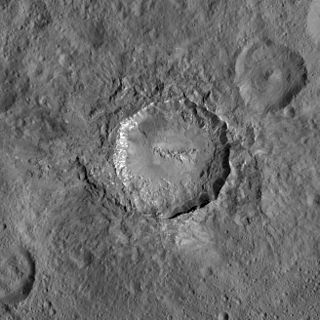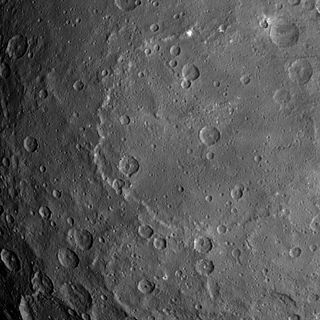 W
WCeres is a dwarf planet in the asteroid belt that lies between the orbits of Mars and Jupiter. The IAU has adopted two themes for naming surface features on Ceres: agricultural deities for craters and agricultural festivals for everything else.
 W
WAchita is a large crater on Ceres.
 W
WAhuna Mons is the largest mountain on the dwarf planet and asteroid Ceres. It protrudes above the cratered terrain, is not an impact feature, and is the only mountain of its kind on Ceres. Bright streaks run top to bottom on its slopes; these streaks are thought to be salt, similar to the better known Cererian bright spots, and likely resulted from cryovolcanic activity from Ceres's interior. It is named after the traditional post-harvest festival Ahuna of the Sumi Naga people of India. In July 2018, NASA released a comparison of physical features, including Ahuna Mons, found on Ceres with similar ones present on Earth.
 W
WAnnona is an impact crater in the southern hemisphere of the dwarf planet Ceres, located at 48.14° S, 8.43° E. It has a diameter of 60 kilometres (37 mi). The crater is named after Annona, a Roman goddess of crops and of the harvest. It was officially named by the International Astronomical Union (IAU) on December 14, 2015.
 W
WAsari is a crater near the north pole of Ceres named for the Assyrian god of agriculture. It is 52 km in diameter.
 W
WSeveral bright surface features were discovered on the dwarf planet Ceres by the Dawn spacecraft in 2015.
 W
WConiraya is a large crater on Ceres
 W
WDantu is a large crater on Ceres. It is rimmed by a number of minor faculae.
 W
WDarzamat is a large crater in the southern hemisphere of the dwarf planet Ceres, located at 44.21° S, 76.4 ° E. It has a diameter of 92 km. The crater is named after Dārza māte, a deity in the Latvian mythology.
 W
WEzinu is a large crater on Ceres. It was officially named in 2015 by the IAU after a Sumerian goddess of grain.
 W
WCeres is a dwarf planet in the asteroid belt that lies between the orbits of Mars and Jupiter. The IAU has adopted two themes for naming surface features on Ceres: agricultural deities for craters and agricultural festivals for everything else.
 W
WHamori is a large crater in the southern hemisphere of the dwarf planet Ceres, located at 60.86° S, 79.44 ° E. It has a diameter of 60 kilometres (37 mi). The crater was named after Hamori, a Japanese god, protector of tree leaves, in 2015.
 W
WHaulani is an impact crater located on Ceres that contains "Spot 1", one of the bright spots observed by the Dawn spacecraft. The crater was named after Haulani, the Hawaiian goddess of plants. In July 2018, NASA released a comparison of physical features, including Haulani crater, found on Ceres with similar ones present on Earth.
 W
WKerwan is the largest confirmed crater and geological feature on Ceres. It was discovered on February 19, 2015 from Dawn images as it approached Ceres. The crater is distinctly shallow for its size, and lacks a central peak. A central peak might have been destroyed by a 15-kilometer-wide crater at the center of Kerwan. The crater is likely to be old relative to the rest of Ceres's surface, as it is overlapped by nearly every other feature in the area.
 W
WMondamin is a large crater in the southern hemisphere of the dwarf planet Ceres, located at 62.24° S, 354° E. It has a diameter of 126 kilometres (78 mi). The crater was named after Mondamin, an Ojibwe corn (maize) god, in 2015.
 W
WNawish is a crater on Ceres. It is named after the Acoma guardian of the field.
 W
WOccator is an impact crater located on Ceres, the largest object in the main asteroid belt that lies between the orbits of Mars and Jupiter, that contains "Spot 5", the brightest of the bright spots observed by the Dawn spacecraft. It was known as "Region A" in ground-based images taken by the W. M. Keck Observatory on Mauna Kea.
 W
WSintana is a large crater in the southern hemisphere of the dwarf planet Ceres, located at 44.21° S, 76.4 ° E. It has a diameter of 58 km. The crater is named after the deity of the Kogi people of northern Colombia who produced fertile black earth. It was officially named by the IAU on July 3, 2015.
 W
WTupo is a crater in the southern hemisphere of the dwarf planet Ceres, located at 32.35° S, 88.38° E. It has a diameter of 36 km. The crater is named after a Polynesian deity, that was invoked on the island Mangareva during the planting of turmeric.
 W
WUrvara উর্বর is the third-largest confirmed crater on Ceres after Kerwan and neighboring Yalode. Urvara means fertile. It is named after the ancient Indo-Iranian personification of fertility. It has a central peak, and a number of unexplained ridges intersect it.
 W
WYalode is the largest confirmed crater on Ceres after Kerwan. It is adjacent to another large crater, Urvara. It is named after the Dahomeyan deity of the yam harvest, Yalodé. It appears to have a series of canyons running from it, in a northwestern direction. These may be ejecta from it. The canyons have been collectively named Samhain Catena.
 W
WZadeni is a large crater in the southern hemisphere of the dwarf planet Ceres, located at 70.36° S, 38.34° E. It has a diameter of 129.3 kilometres (80.3 mi). The crater is named after Zaden, or Zadeni, the Kartli (Georgian) god of fruitfulness. The International Astronomical Union (IAU) Working Group for Planetary System Nomenclature (WGPSN) assigned the name after the crater's discovery during the Dawn mission.